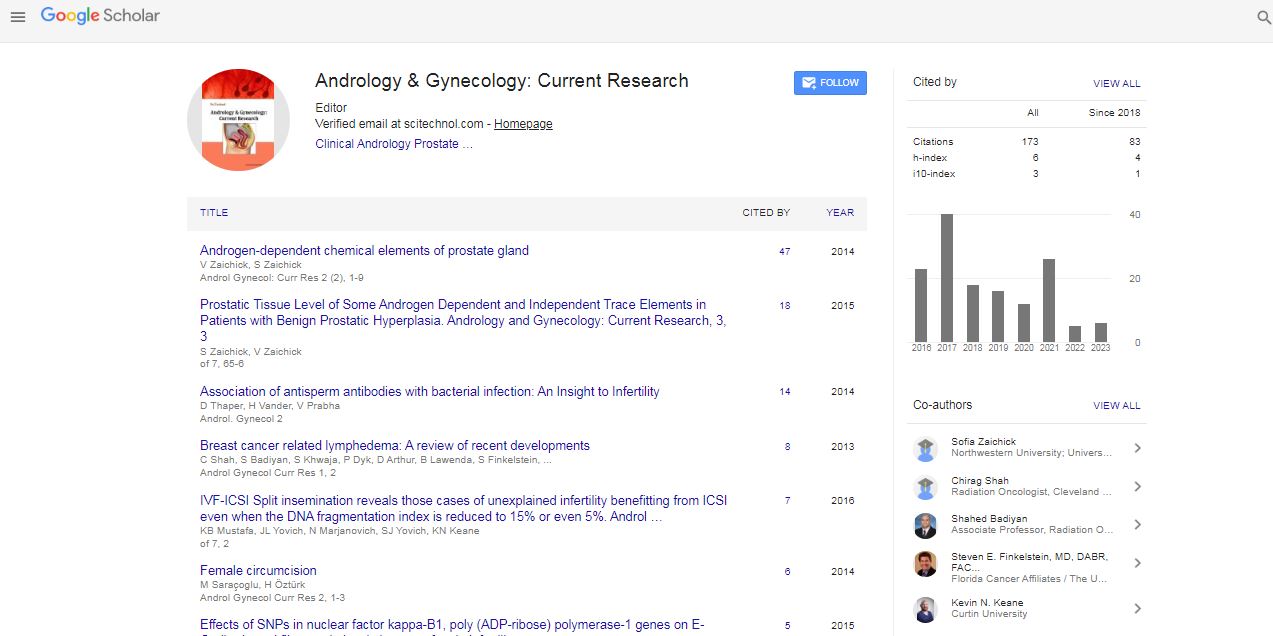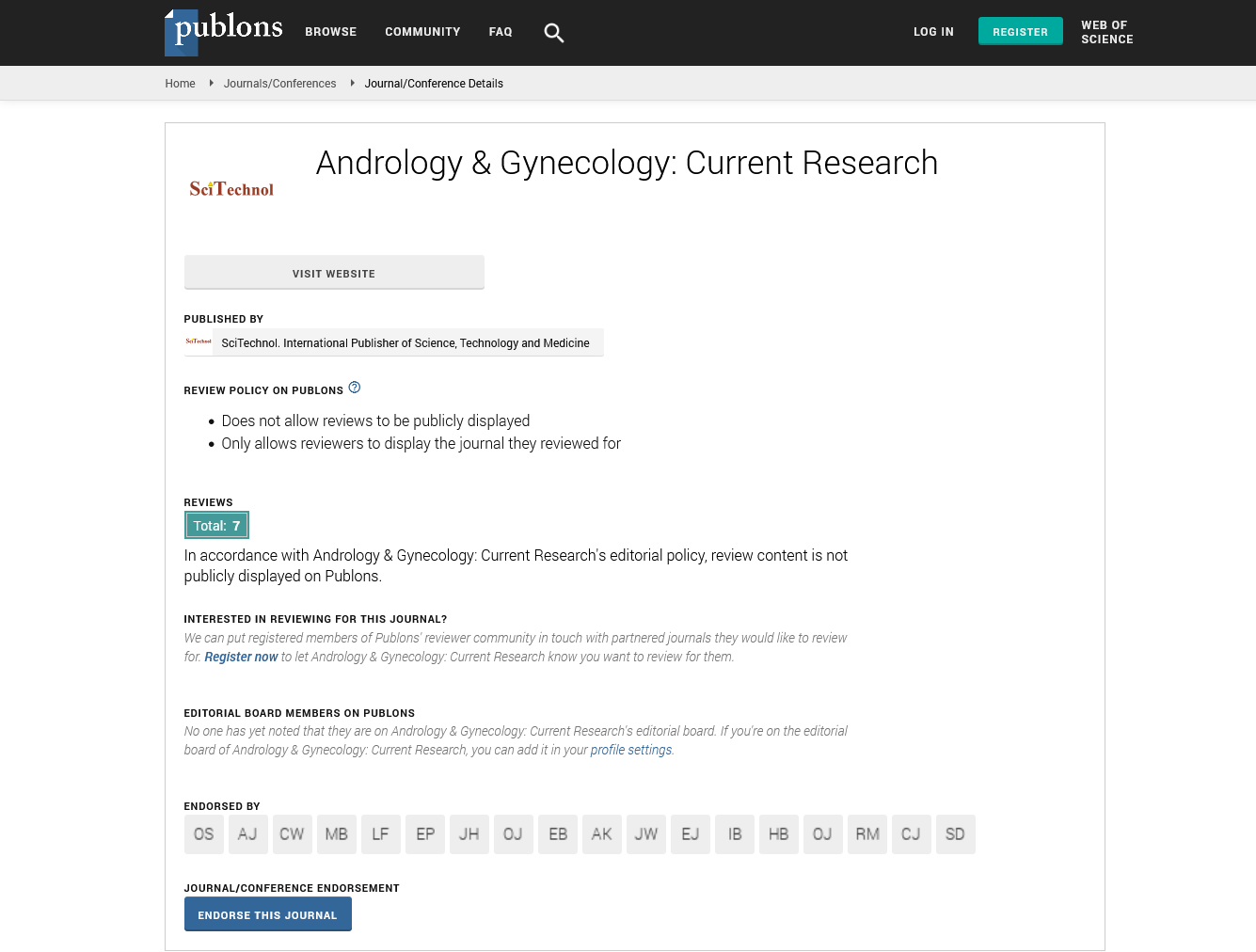Editorial, Androl Gynecol Curr Res Vol: 1 Issue: 2
Is there a True Link between HCV and Pathogenesis of RCC?
| Asim B Abdel–Mageed and Krishnarao Moparty* | |
| Department of Urology, Tulane University Health Sciences Center, New Orleans, Louisiana, USA | |
| Corresponding author : Krishnarao Moparty, MD Department of Urology, Tulane University Health Sciences Center, 1430 Tulane Avenue, SL-42, New Orleans, Louisiana 70112, USA Tel: 504-988-2750; E-mail: kmopart@tulane.edu |
|
| Received: March 14, 2013 Accepted: March 16, 2013 Published: March 20, 2013 | |
| Citation: Moparty K (2013) Is there a True Link between HCV and Pathogenesis of RCC? Androl Gynecol: Curr Res 1:2. doi:10.4172/2327-4360.1000e104 |
Abstract
Is there a True Link between HCV and Pathogenesis of RCC?
It is estimated that approximately 3% (130-200 million) of the world population are infected with chronic hepatitis C virus (HCV). 130–200 million people, or ~3% of the world’s population, are living with chronic hepatitis C. Approximately, 350,000 deaths and 4 million new cases are confirmed annually from HCV-related diseases. In the United States, 35,000-185,000 new cases are reported with an estimated death 8,000-10,000 annually.
| It is estimated that approximately 3% (130-200 million) of the world population are infected with chronic hepatitis C virus (HCV). 130–200 million people, or ~3% of the world’s population, are living with chronic hepatitis C [1]. Approximately, 350,000 deaths and 4 million new cases are confirmed annually from HCV-related diseases. In the United States, 35,000-185,000 new cases are reported with an estimated death 8,000-10,000 annually [2]. Intravenous medications and poor hygienic practices in public and private medical and dental facilities are implicated in increasing the incidence of HCV in the 20th century [3]. These culprits include the reuse of needles, infusion bags, and improperly sterilized surgical equipments [3]. Additionally, blood transfusion and organ transplantation, without HCV screening, pose significant risks of infection [2]. Vertical transmission from pregnant women to their newborns has been reported in about 10% of pregnancies [4]. | |
| The HCV-related death is attributed to hepatic disorders including cirrhosis, liver failure, and hepato cellular carcinoma. However, chronic HCV infection has also been associated with development of extra hepatic diseases, such as vasculitis, cryoglobulinemia, and various renal disorders [5]. The expression of HCV ribonucleic acid (RNA) and core protein have been shown in glomerular and tubular structures in patients with chronic kidney disease (CKD), which implicates a role for HCV in the pathogenesis of CKD [6]. | |
| Among patients with HCV-mediated chronic kidney disease (CKD), HCV RNA and core protein have been isolated in kidney glomerular and tubular structures [6]. Interesting, chronic HCV infection has been linked to development of non-hodgkin lymphoma and hematopoietic malignancies [7], suggesting that HCV may have extra hepatic oncogenic potential. However, the underlying mechanisms remain elusive. | |
| Renal cell carcinoma (RCC), also known as renal cell cancer or renal cell adeno carcinoma, originates in proximal convoluted tubule. RCC is the most lethal of all the genitourinary tumors and is by far the most common type of kidney cancer. RCC accounts for approximately 90% of kidney cancer cases in adults [8]. The average 5-year survival rate is 60-70% in organ-confined disease, but significantly decreases with development of metastasis. Various treatment options, such as radiation therapy and chemotherapy and immunotherapy, are available, although radical or partial nephrectomy remains the mainstay curative treatment of RCC [9]. | |
| The global incidence of RCC has been rising steadily over the past 2 decades [10]. According to the American Cancer Society (ASC), an estimated 65,150 new cases of RCC are expected to be diagnosed, with anticipate death rate of 13,680, in the United States in 2013 [11]. Although the reasons are unclear, the incidence of RCC appears to be influenced by gender and race. To this end, higher incidence is reported in women, especially among African Americans in comparison to Caucasians [12]. The incidence of RCC has almost doubled in Europe over the last four decades [13]. | |
| The RCC is the third highest among genitourinary (GU) cancers with a 25 percent mortality rate from RCC. About 65-70 percent of them were diagnosed incidentally from CT scans performed for other disease conditions, such as GI, abdominal pain, degenerative disease of the spine or staging for lymphomas. Despite increasing incidence and mortality rates, little is known about the underlying causes of RCC. Many risk factors, encompassing smoking, obesity (high body mass index) exposure to cadmium, asbestos, benzene and organic solvents, among others, have been implicated in RCC. Additionally, RCC is also been associated with VHL, tuberous sclerosis and birt hogg dube complex. RCC is mainly diagnosed from flank pain, hematuria and abdominal mass. Early diagnosis has led to the use nephron sparing surgery through laparoscopic or robotic approaches for treatment of RCC. Recently, we have noticed potential relationship between RCC and HCV, but the exact relationship was not well understood. | |
| Intriguingly, a number of recent studies have suggested an association of HCV to the development of RCC. Detection of RCC, within a relatively short-time frame in patients with HCV infection, suggested an oncogenic potential role for the virus in the pathogenesis of RCC [14]. A number of case reports documented synchronous hepato cellular carcinoma or HCV with RCC in liver transplant and hemodialysis patients, candidates and recipients [15-17]. Recently, a large cohort study in an ethnically diverse healthcare system explored whether HCV infection confers an increased risk for developing RCC. A cohort of 67,063 HCV-tested patients between 1997 and 2006 were followed for the development of RCC until 2008 [18]. The results show 0.6% (17 of 3,057) of HCV-positive patients had RCC versus 0.3% (177 of 64,006) in HCV-negative patients. The hazard ratio for RCC among HCV patients was 2.20, whereas the overall hazard ratio for RCC among HCV patients was 1.77. Chronic HCV infection confers a risk for the development of RCC. The authors suggested that clinicians should consider newly identified renal lesions in patients with chronic HCV infection. | |
| Taken together, the aforementioned studies strongly established a link between RCC and HCV infection; however, further studies are required to elucidate the oncogenic potential of HCV in the pathogenesis of RCC. Likewise, larger studies are needed to establish if screening, rather than surveillance, is imperative for the presence of HCV infection in newly diagnosed patients with RCC. | |
References |
|
|
 Spanish
Spanish  Chinese
Chinese  Russian
Russian  German
German  French
French  Japanese
Japanese  Portuguese
Portuguese  Hindi
Hindi 


